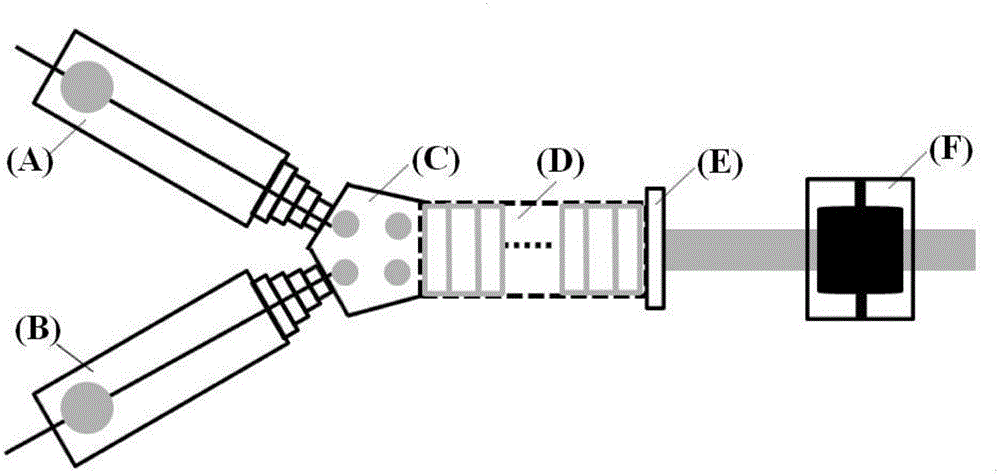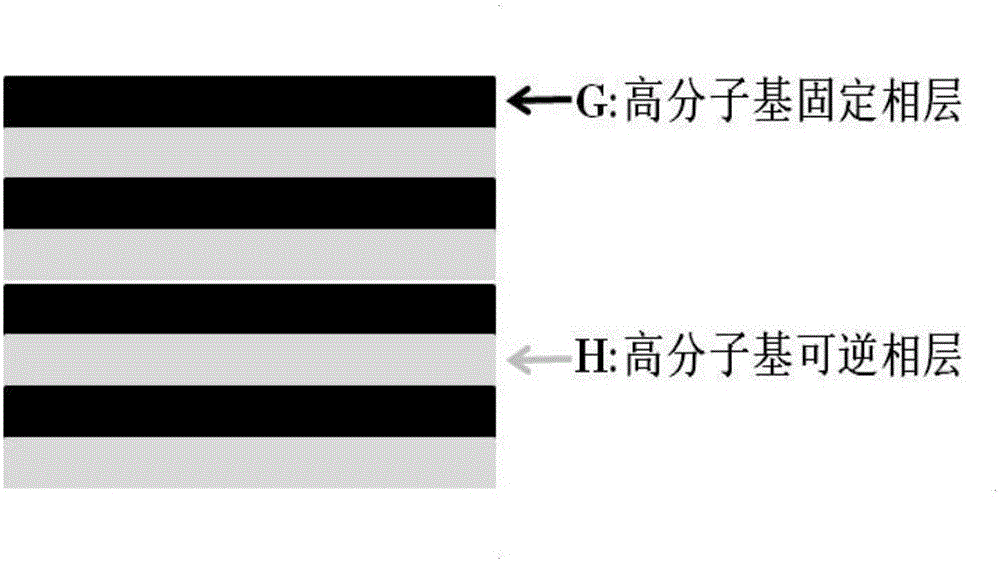Preparation method of novel polymer-based multilayer shape memory material
A polymer material and polymer-based technology, applied in the field of preparation of new polymer-based multilayer shape memory materials, can solve problems such as extended production cycle, low production efficiency, and difficult characterization, and achieve improved shape memory performance and good fixation , the effect of enriching layer interface
- Summary
- Abstract
- Description
- Claims
- Application Information
AI Technical Summary
Problems solved by technology
Method used
Image
Examples
Embodiment 1
[0041] (1) Styrene-ethylene-butylene-styrene block copolymer (SEBS) (D-1161JP, KRATON ) was selected as the polymer-based stationary phase layer material; polycaprolactone (PCL) (6800, Perstorp Corp) As a polymer-based reversible phase layer material. Before use, the raw materials were placed in a vacuum oven and dried at 80 °C and 40 °C for 24 h to remove moisture.
[0042] (2) Put SEBS and PCL into two extruders (A, B) of the multi-layer extrusion system respectively (see figure 1 ), adjust the speed ratio of the extruder to 1:1, and control the temperature of each section of the extruder at 80-175-190-190˚C and 50-175-190-190˚C respectively. After the material in the extruder is melted and plasticized, the two melts are superimposed in the three-channel confluence C to obtain an initial structure with 3 layers, and then cut and layered by 8 layer multipliers D After being superimposed, it flows out from the outlet die E of the rectangular flow channel, in which the temper...
Embodiment 2
[0047] (1) Styrene-polybutadiene-styrene block copolymer (SBS) (YH-791, Balin Petrolem) was selected as the polymer-based stationary phase layer material; polycaprolactone (PCL) (6800, Perstorp Corp ) as a polymer-based reversible phase layer material. Before use, the raw materials were placed in a vacuum oven and dried at 80 °C and 40 °C for 24 h to remove moisture.
[0048] (2) Put SBS and PCL into two extruders (A, B) of the multi-layer extrusion system respectively (see figure 1 ), adjust the speed ratio of the extruder to 7:1, and control the temperature of each section of the extruder at 80-165-180-180°C and 50-165-180-180°C respectively. After the material in the extruder is melted and plasticized, the two melts are superimposed in the three-channel confluence C to obtain an initial structure with 3 layers, and then cut and layered by 12 layer multipliers D After being superimposed, it flows out from the outlet die E of the spiral flow channel, in which the temperatur...
Embodiment 3
[0053] (1) Polyolefin elastomer (POE) (8150, DuPont) was selected as the polymer-based stationary phase layer material; polycaprolactone (PCL) (6800, Perstorp Corp) was selected as the polymer-based reversible phase layer material. Before use, the raw materials were placed in a vacuum oven and dried at 80 °C and 40 °C for 24 h to remove moisture.
[0054] (2) Put POE and PCL into two extruders (A, B) of the multi-layer extrusion system respectively (see figure 1 ), adjust the speed ratio of the extruder to 1:1, and control the temperature of each section of the extruder at 80-175-190-190˚C and 50-175-190-190˚C respectively. After the material in the extruder is melted and plasticized, the two melts are superimposed in the three-channel confluence C to obtain an initial structure with 3 layers, and then cut and layered by 12 layer multipliers D After being superimposed, it flows out from the outlet die E of the rectangular flow channel, in which the temperature of the confluen...
PUM
| Property | Measurement | Unit |
|---|---|---|
| hardness | aaaaa | aaaaa |
Abstract
Description
Claims
Application Information
 Login to View More
Login to View More - R&D
- Intellectual Property
- Life Sciences
- Materials
- Tech Scout
- Unparalleled Data Quality
- Higher Quality Content
- 60% Fewer Hallucinations
Browse by: Latest US Patents, China's latest patents, Technical Efficacy Thesaurus, Application Domain, Technology Topic, Popular Technical Reports.
© 2025 PatSnap. All rights reserved.Legal|Privacy policy|Modern Slavery Act Transparency Statement|Sitemap|About US| Contact US: help@patsnap.com



